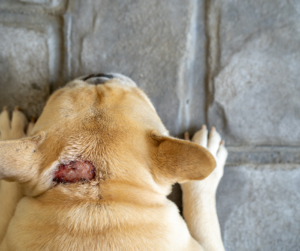 Hot spots, scientifically known as acute moist dermatitis, are a common skin condition that can cause discomfort and irritation for our furry companions. These localised areas of inflammation and infection can appear suddenly and escalate rapidly if not addressed promptly. Here’s what you need to know about hot spots in dogs and how to manage them effectively:
Hot spots, scientifically known as acute moist dermatitis, are a common skin condition that can cause discomfort and irritation for our furry companions. These localised areas of inflammation and infection can appear suddenly and escalate rapidly if not addressed promptly. Here’s what you need to know about hot spots in dogs and how to manage them effectively:
What Are Hot Spots?
Hot spots are moist, red, and inflamed patches of skin that often develop due to a variety of underlying factors, including allergies, insect bites, poor grooming, or skin trauma. They typically occur on the head, neck, hips, and limbs and can quickly worsen as dogs lick, scratch, or chew at the affected area, leading to further irritation and infection.
Recognising the Symptoms
– Red, inflamed patches of skin
– Moist or oozing lesions
– Intense itching or licking
– Hair loss in the affected area
– Foul odor
– Pain or discomfort when touched
Causes of Hot Spots
Several factors can contribute to the development of hot spots in dogs, including:
1. Allergies: Environmental allergens, such as pollen, mold, or dust mites, can trigger allergic reactions in susceptible dogs, leading to itching and skin irritation.
2. Parasites: Fleas, ticks, and mites can bite and irritate the skin, causing dogs to scratch and create hot spots.
3. Skin Infections: Bacterial or fungal infections, often secondary to scratching or skin trauma, can exacerbate hot spots and delay healing.
4. Moisture: Excessive moisture or dampness on the skin, such as from swimming or bathing, can create an ideal environment for bacterial growth and hot spot development.
Treatment and Prevention
1. Keep the Area Clean and Dry: Gently cleanse the affected area with a mild antiseptic solution and pat it dry with a clean towel. Avoid further irritation by trimming the hair around the hot spot.
2. Topical Treatments: Apply a veterinarian-recommended topical medication, such as a medicated spray or ointment, to help soothe the skin, reduce inflammation, and promote healing.
3. Prevent Further Trauma: Prevent your dog from licking, scratching, or chewing at the hot spot by using an Elizabethan collar (cone) or covering the area with a breathable bandage.
4. Identify and Address Underlying Causes: Work with your veterinarian to identify and address any underlying factors contributing to your dog’s hot spots, such as allergies or skin infections. This may involve allergy testing, parasite control, or dietary changes.
5. Maintain Good Grooming Habits: Regular grooming, including brushing and bathing with a hypoallergenic shampoo, can help prevent mats, tangles, and skin irritation that may contribute to hot spot formation.
6. Environmental Management: Minimise exposure to potential allergens or irritants in your dog’s environment, such as pollen, mold, or harsh chemicals, to reduce the risk of allergic reactions and hot spots.
When to See a Veterinarian
If you notice signs of infection, such as pus, swelling, or fever, it’s essential to seek veterinary attention promptly. Your veterinarian can prescribe appropriate medications, such as antibiotics or anti-inflammatory drugs, and recommend further treatment options to help your dog recover quickly and comfortably.
By understanding the causes, symptoms, and treatment options for hot spots in dogs, you can take proactive steps to keep your furry friend healthy, happy, and free from discomfort this summer and beyond. Remember, early intervention and proper management are key to resolving hot spots and preventing their recurrence in the future.
